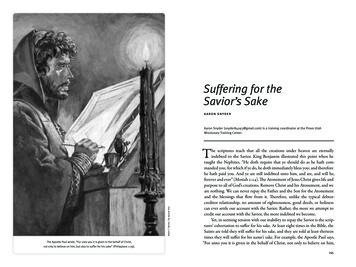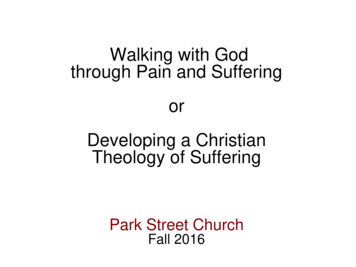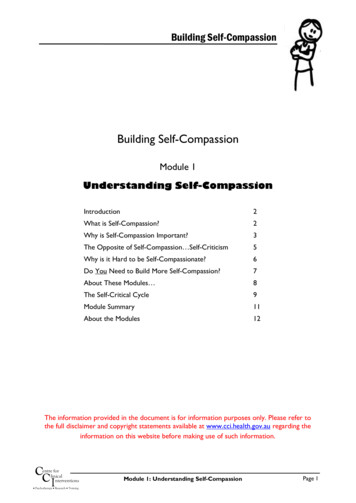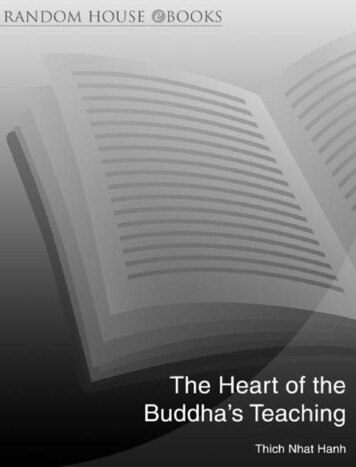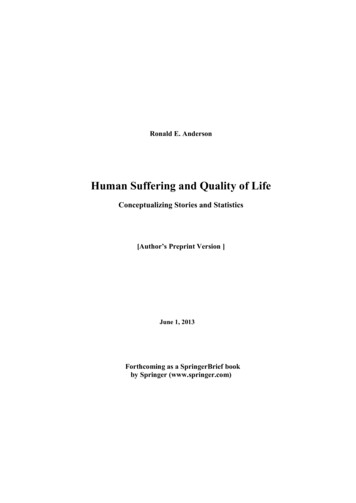
Transcription
Ronald E. AndersonHuman Suffering and Quality of LifeConceptualizing Stories and Statistics[Author’s Preprint Version ]June 1, 2013Forthcoming as a SpringerBrief bookby Springer (www.springer.com)
2Ronald E. Andersonrea@umn.eduDepartment of Sociology909 Social Sciences Bldg.University of MinnesotaMinneapolis, MN 55455USA
3About the AuthorRonald (Ron) Anderson is Professor Emeritus at the University of Minnesota. He received his PhD in sociology from Stanford University in 1970.From 1968 until retiring in 2005, he served on the faculty of sociology atthe University of Minnesota. Throughout that time, he consulted for manygovernment agencies and corporations on survey research and technologyrelated issues. From 1990 to 2005, he coordinated several internationalstudies of the social and learning effects of information technology withinprimary and secondary education in 20 or more countries in each study.From that and earlier work, he wrote or edited seven books and over 100articles. Since retirement, his research interests have focused primarily oncompassion and suffering. Further details on his work can be found in thefollowing websites:en.wikipedia.org/wiki/Ronald Andersonwww.soc.umn.edu/ rea/StopSuffering.net.
4PrefaceThe original intent of this little book is to take on four very big challenges: (1) a framework that makes it easier to think about suffering andmeasure it, (2) a compilation of available data on how much suffering exists in the world, (3) rationales for why people should become more awareof the vast volume of severe suffering around the world, and (4) justification for giving higher priority to the reduction of suffering in our personal,state, and global policy objectives. With these goals, you should not besurprised that the book looks at suffering from many different angles.After 40 years of teaching sociology and research strategies at the University of Minnesota, I retired in order to just do research, travel and volunteer work. Making this major life change forced me to confront questions of meaning, especially: What makes life worth living? What is themeaning of suffering? What can one do in later life to optimally contributeto ultimate concerns of human beings? My first major conclusion was thatcompassion is most needed to secure the human race. But after focusing oncompassion for several years, I came to realize that the efficacy of compassion is constrained by the huge supply of suffering in the world, whichonly seems to be expanding.When I started reading what others had learned about suffering, I discovered a void of knowledge and concluded that doing pioneering researchon suffering would be the best way I could use my talents and experience.It has been exciting to discover some elements of suffering, which are asold as human consciousness itself.This brief book of about 125 pages, follows the structure and format ofall SpringerBriefs, of which there are thousands. In the SpringerBriefmodel, each chapter is like a separate article with its own abstract, keywords, footnotes and references. This requirement, I believe, is a good onebecause it forces the author to make each chapter convey a completestatement of its own, but at the same time make the chapters flow togetherso that the entire set is an integral whole.The first chapter begins by explicitly defining some very different typesof suffering from which a taxonomy emerged. People think about sufferingin very different ways, depending upon their backgrounds in religion, localculture, and unique personal experiences. Chapter 1 discusses eight‘frames for suffering’ and Chapter 2 supplies stories for each way of thinking about suffering. How suffering shapes peoples’ quality of life becomesclearer through these stories.
5Statistics offer only fleeting glimpses of the distress and agony sufferedby some in the course of everyday life. But in Chapter 3, you will see howour taxonomy of suffering helps organize and add meaning to statistics onthe health of America adults. People react differently to suffering, depending upon whether it is primarily pain, depression, anxiety, grief, existentialsuffering, or social suffering.Before you read in Chapter 3 how many American adults live with extreme suffering, guess the percentage. Of course, it depends on how onedefines ‘extreme,’ but reflect on the question before and after digesting thestatistics.Another important question is how much extreme suffering affects people’s quality of life (QOL). The answer may surprise you. Finding so muchsuffering in a contemporary, affluent society raises the possibility that affluence itself, through lifestyles and beliefs produces types of sufferingnot typically found in poverty stricken nations.Chapter 4 shifts to a global perspective and offers pioneering indicatorsfor both subjective and objective suffering country by country. Besidesranking countries by their degree of suffering, the chapter notes how socialsupport networks seem to help people living in different cultures cope withsuffering more easily.Alternative approaches to the alleviation of suffering depend upon thetype of suffering, but all types need to be addressed on both the individualand institutional levels. Data comparing nations as well as states in Chapter 5 show the miss-alignment between suffering and available care resources that may help relieve those who suffer. A major finding is thatglobal inequality is a major cause of suffering and widens gaps in care forthose who suffer.Working toward ending needless suffering is both a personal value anda public good that offers hope to those who suffer now or in the future.Chapter 6 reviews the ethical grounds for alleviating suffering. It also discusses strategies for relief of suffering and notes how the relief of sufferinghas to be both an individual and a collective effort. Recommendations areoffered for incorporating the relief of suffering more fully into social policy for development as well as for individual decision-making.
6Table of ContentsAbout the Author . 3Preface . 4Table of Contents . 6Conceptualizing Human Pain and Suffering. 81.1 The Suffering Concept. 91.2 A Taxonomy for Pain and Suffering . 121.3 Frames for Thinking about Suffering . 161.4 Conclusions . 23References . 24Narrative Accounts of the Agony of Suffering . 282.1 The Significance of Narratives of Pain and Suffering . 282.2 Narratives of Suffering on the Internet . 302.3 Conclusions . 40References . 41Statistical Portrait of Suffering in America. 433.1 Data for Measuring Suffering in the United States. 443.2 Indicators of Specific Types of Suffering . 453.3 Sex, Age, and Income Differences in Suffering . 543.4 Quality of Life and Suffering . 583.5 Implications . 613.6 Summary . 613.7 Conclusions . 62References . 64Suffering on a Global Scale . 664.1 Applying the Notion of Global Suffering . 674.2 Subjective Suffering . 684.3 Types of Calamities Related to Suffering . 724.4 Construction of an Objective Suffering Indicator. 754.5 Multidimensional Suffering and Gender Inequality . 784.6 Multidimensional Suffering and Social Supports . 804.7 Conclusions . 86References . 87
7World Suffering Expands as Gaps in Care Widen . 895.1 Alternative Approaches of Responding to Suffering . 905.2 The Care Divide. 945.3 How the Rich Undermine Reduction of World Suffering . 1025.4 Inequality and the Widening of Care Divides . 1045.5 Inequality, Income Segregation and World Suffering . 1055.6 Implications . 106References . 108Ending Preventable Suffering: Ethics and Social Change . 1116.1 Ethical Foundations for the Relief of Suffering. 1126.2 Individual Actions to Relieve Suffering . 1146.3 Institutional Change to Relieve Suffering . 1176.4 Change in Social Policy for Aid and Welfare Programs . 1176.5 Implications for Quality of Life Research . 1196.6 Cutting Edge, Contentious Issues Related to Suffering . 1196.7 Conclusion . 123References . 124INDEX . Error! Bookmark not defined.
8Chapter 1Conceptualizing Human Pain and SufferingAbstract Humans spend much of life suffering or trying to avoid suffering, yet there is little precision or consistency in the definition of ‘suffering’. To rectify that, a classification scheme or taxonomy is outlined thatdistinguishes mental, physical, and social suffering, and then offers subcategories. For example, depression, anxiety, grief, and existential suffering are all types of mental suffering. Suffering is defined as distress resulting from threat or damage to one’s body or self-identity. Next, to capturethe principal, dominant cultural meanings of suffering, eight frames (essentially, major points of view) for suffering are summarized. Theseframes are suffering as punishment, suffering as reward, suffering as craving, suffering as sacrifice, suffering as natural destiny, suffering as manageable, relief of suffering as human purpose, and lastly, relief of sufferingas progress in quality of life. Suffering and negative quality of life have alot in common. Understanding perceptions of peoples’ desired relief ofsuffering requires that we distinguish their own suffering from suffering ofothers important to them. Thus, in measuring subjective quality of life, itmay be necessary to distinguish a person’s perception of their own qualityof life from that of others who are important to them.Keywords Anxiety, Depression, Emotions, Existential suffering, Grief,Physical suffering, Suffering, Meaning of life, Pain, Quality of life, Relieving suffering, Social suffering,
9When we suffer, our quality of life declines—it is an intuitive idea.What is not so obvious, however, is that by intertwining suffering andquality of life in our thinking, we can better understand and cope with suffering (whether our own or others’). To begin pulling these concepts together, I highlight relevant social scientific literature and suggest eightframes or ways of thinking about and investigating human suffering. Inlater chapters, I will have examples from stories about suffering and statistics showing the spread of suffering, both national and global.1.1 The Suffering ConceptImagine yourself undergoing major surgery two hundred years ago.While some cultures had used pain-relieving herbs and other natural substances for millennia, you are in Europe or America, where such palliativesare not yet used. You will not be given anesthesia (beyond, perhaps, somealcohol). Essentially, you are facing torture. This is what happened toFrances Burney, a wealthy English writer living in France in 1810. She lefta vivid story of suffering as she described six surgeons’ work to removeher breast tumor. Journal entries of her unimaginable pain have been described by Dormandy (2006) and preserved by Hemlow (1975). Her pain,unchecked by any anesthesia, sears the page:“When the dreadful steel was plunged into mybreast, I released an unremitting scream . I felt theknife rackling against the breast bone, scraping itwhile I remained in torture . When I opened myeyes I saw the good Dr. Larrey, pale nearly as myself, his face streaked with blood, and depictinggrief, apprehension and almost horror” (Hemlow1975).Burney’s recollection is a monument to the raw pain and suffering ofboth patients and doctors. The doctor’s suffering, resulting from compassion, attests to the reality of collective—or social—suffering.For those of us living in an era of high-quality anesthetics and laser surgery, Burney’s agony reads like primitive depictions of hell. Through herwords, we empathize. Yet as you read this sentence, millions of peoplesuffer in dark corners of the globe, just as millions have in the past, and,potentially, millions will in the future (Amato 1990). Every day, our fellowhuman beings face torture, rape, and excruciating trauma (Bourdieu 2000;Dormandy 2006; Trachtenberg 2008; Vollman 2005).
10Now, not all pain and suffering is extreme, bordering on the unbearable.Pain and suffering range from the infinitesimal to the unimaginably excruciating. And both pain and suffering may last seconds or lifetimes. Theymay be fleeting or chronic.Pain and suffering may also be individual or social. Often we cut a finger, occasionally a friend dies, but such suffering is not distributed evenlyacross social strata, much less the globe (Anderson 2011, 2012; Bock2011; Diener, Kahneman, Tov & Arora 2009). While severe sufferingfrom violence and injury occur more often in the Global South, particularly in pockets of poverty, studies in western societies generally concludethat at least 20% of adults suffer from chronic pain, the reoccurrence ofsevere pain over several months or longer (Breivik et al. 2006; Chabal2009; Collier 2007; Nagappan 2005; Kleinman 2009a; 2009b; 2011). Suffering is pervasive, if not always shared.In this book, the word ‘suffering’ will be used as an all-inclusive term,subsuming pain. However, Table 1.1, which identifies three categories ofsuffering and provides a brief entry of descriptors for each, categorizespain as separate from other types of suffering. Our language is filled withwords that imply affective or emotional responses to events or objects thatresult in negative feelings, many of which are listed in Table 1.1. For example, grief as a type of suffering is viewed by Charmaz and Jilligan(2006) as a composite of many emotions and cognitions including fear andsorrow.In the spirit of Cassel (2004) and Chapman and Volinn (2005), who defined suffering as perceived threat or damage to a sense of self, here suffering is defined as distress resulting from threat or damage to one’s bodyor self-identity. Suffering can vary in intensity, duration, awareness andsource. Physical suffering is the subset of distress resulting from threat ordamage to one’s physical being, whereas mental suffering is distress perceived as originating in one’s cognitive or affective self-identity. Selfidentity is the set of characteristics and their meanings observed when onelooks at oneself.Physical suffering is equated with pain, even though it often co-occurswith mental suffering (Black 2005; Carr et al. 2005; Livingston 1998;Morris 2002; Wilson et al. 2009), while mental suffering includes cognitive suffering (thoughts that produce suffering) and emotional suffering(Francis 2006; Nott 2011).
11Table 1.1 Words Associated with Common Types of SufferingSuffering TypeWords for SufferingPhysicalagony, discomfort, excruciation, hurt, incapacitation,Suffering (Pain) torture, torment, soreness, acute pain, chronic pain,extreme pain, excruciating pain, unimaginable painMentalanguish, angst, anxiety, addiction, distress, troubled,Sufferingcraving, post-traumatic stress disorder, compulsivedisorder, loss, mourning, grief, sadness, disgust, irritation, anger, rage, hate, contempt, jealousy, envy,frustration, heartbreak, fear, panic, horror, indignation, shame, guilt, remorse, regret, resentment, repentance, embarrassment, humiliation, boredom, apathy, confusion, disappointment, hopelessness, doubt,emptiness, homesickness, loneliness, rejection, pity,self-pity, nervousness, restlessness, minor depression,chronic depression, severe depression, hopelessness,self-worthlessness, spiritual confusion, purposelessness, other types of loss of meaningSocial Suffering social exclusion, discrimination, ostracized, persecution, incapacitation, disability, shame (selfostracized), distrust, relative deprivation, subjugation,atrocity, homelessness, unemployment, social rejection, discrimination, bullied, disability, blindness,deafness, bedridden, hunger, war, civil violence, survival risk factorsFor present purposes, social suffering is defined as suffering whosesources are social collectivities and/or social institutions. Social suffering,which will be discussed at much greater length in the next section, differsin that it refers to the social contexts that shape the suffering of both individuals and collectivities. Social suffering typically co-occurs with othertypes of suffering, results from social forces, and results in social change(Das et al. 2001; Farmer 1997; Kleinman 1988; 2006; Kleinman et al.1997; Nordgren et al. 2011; Wilkinson 2005a, 2012). Genocide, battlefieldslaughters, and lynching are well-known examples. Research on social suffering has uncovered that those affected by such dreadful events suffer inpart from a devastating loss of their identity as human beings (Bourdieu2000; Kleinman et al. 1997; Wilkinson 2005).Existential suffering (later combined with mental suffering) is the result of struggles with the meaning of one’s existence (Langle 2008). Thismay seem like a lofty idea, but you might think of it as a struggle in which
12you question the meaning of your life (or life itself). A common course ofexistential suffering is confrontation with death and other threats to one’sexistence. Williams (2004) interviewed low-income cancer victims receiving end of life care. In many instances, the patients’ suffering was compounded by wondering how their impending death could square with theirbeliefs about life’s meaning. On top of that, some felt left out or treated asnon-persons as death approached. Here is how a 42-year-old man described the experience:“People talk as if you’re not there. One of mother’sfriends died of cancer last week, and people aroundme were talking all about the funeral, like theydidn’t even think it might bother me. It gets to meand makes me feel my life isn’t worth anything compared to theirs” (Williams 2004).This narrative demonstrates how social and existential suffering may occurtogether, amplifying the degree of tragedy and suffering.1.2 A Taxonomy for Pain and SufferingPain is such a complex phenomenon that thousands of scientists haveyet to isolate and understand all its aspects. A noted figure in the science ofpain, Livingston (1998), said at one point that “nothing can be properlycalled pain unless it is consciously perceived as such.” The word ‘pain’ isderived from the Greek poine and the Latin poena, both of which referredprimarily to punishment or penalty. (Like other primitive peoples, the earlyGreeks believed their many gods handed out rewards and punishments andboth were generally received by people as pain.)Aristotle spoke of pain and pleasure as “passions of the soul,” andclaimed “wherever there is sensation there is also pain or pleasure” (Livingston 1998). To this day, many associate pain and suffering with mattersof the soul and spirituality. Because severe pain easily preoccupies themind, we should not be surprised that people often seek to know why andhow they became the victims of the pain. Suffering may lead to speculation on existential matters like the meaning of pain and suffering in one’slife and in the larger schemes or purposes of life. In discussing the sociology of emotions, Francis (2006) asserts that emotions play a major role inpain and suffering, how the victim interprets the meaning of pain affectsthe emotions evoked.
13In a modern definition that takes into account emotion (if not spirituality), the International Association for the Study of Pain states: "Pain is anunpleasant sensory and emotional experience associated with actual or potential tissue damage" (Merskey & Bogsuk, 1994). Thus, pain is perceivedas a negative emotional and sensory experience (Brattberg et al. 1996; Das1997b; Sontag 2003).Pain and suffering are often used synonymously, but suffering also refers to psychological or social hurt (whether or not that hurt originatedfrom the negative physical sensation we call pain). Suffering also encompasses social affliction and stress, as well as the emotional component ofpain. As pain has a physiological and/or neurological character, and because it affects health so directly, it has been extensively investigated byscientists. Furthermore, pain management has become a major health carefield and a large industry in western societies. The phrase ‘pain and suffering’ even has a special meaning within the legal system.To consider suffering separately for a moment, though, we can startwith its origins. The word suffering emerged from Middle English wordsuffrir and the Latin word suffero, both of which were defined as being‘long-suffering’ or facing a burden of pain with patience. Over severalhundred years, the word lost its reflection of endurance and remained averbal representation of hardship, distress, and turmoil.Suffering is used in so many different ways that the very word mightbecome a barrier rather than an aid to understanding. Carefully consideredtaxonomies can prevent confusion, and that is why I explored the manysynonyms and meanings of suffering in Table 1.1. To refine our thinking, Ithen constructed Table 1.2 by reviewing the use of words like suffering,pain, misery, and distress in the academic literature and in popular works. Icompared the best sources to see where they agreed on the dimensions ordomains of suffering. These dimensions include not only different types ofsuffering, but diverse causes, outcomes, and meanings.In the interest of brevity, only three categories of suffering appear ascolumns in Table 1.2. Here, existential suffering is considered mental suffering.
14Table 1.2 Examples of Suffering by their Source (rows) and Type (columns)Physical Suffer- Mental Suffering Social Sufferinging (Pain)Primarily ProSuicide, selfParanoia, lowWorry, fear, perduced Internally flagellation,self-regard, un- ceived violence,self-abusewarranted fear,imagined threatsanger, othersuch as bullying,negative emoshame, envy,tionsgreed, jealousyPrimarilyInjuries fromLoss of goodsCollective starvaCaused Externatural disasters and others livtion, homelessnally by Natureing beings from ness, injurynatural disastersPrimarilyTorture, rape,Threats of hosInjuries, rape,Caused Exterbullyingtile act (e.g.,gang violence andnally by Personsrape, bullying)assaults, stalkingor Small GroupsPrimarilyHunger, starva- Threats of perse- War casualties,Caused Extertion, illness, in- cution (e.g., rac- collective rape,nally by institu- jury, poverty,ism, PTSD)incarcerations,tions, societies, sexism, politicaldiscrimination,social forcesviolencestigmaYou will notice that each category represented by a row in the table begins with the word primarily. Very often, any given instance of sufferinghas multiple causes and multiple processes as represented by the columnsof the table.Now, human suffering can only be fully understood from the accumulation of knowledge about its causes, contexts, and results. Suffering is sobroad that knowledge is needed from many disciplines, including the humanities, social sciences, biological sciences, and professional health care.However, discerning the mutual interplay between suffering and the quality of life depends largely upon knowledge and tools from within socialscience research. This is why qualitative, quantitative, historical, and comparative methods provide the basis for my investigation in the rest of thechapter.Social suffering is a relatively new label. The term emerged from anthropologists and sociologists studying pain and suffering ethnographically. Medical anthropologists Kleinman, Das and Locke (1997) wrote thefirst book titled Social Suffering, and they continue to work on the con-
15struct, most recently applying it to global humanitarian policy (Kleinman2010b, 2011; Farmer 2005, 2006). Das (1997b) and another medical anthropologist, Morris (2002), have helped explicate the concept. SociologistWilkinson (2005) devoted his book on suffering to applying and enhancingthe notion of social suffering, which he defined as suffering produced bysocial forces, rendering the victim without a sense of being human andworthwhile. Using the Holocaust, the Rwandan Genocide, and similaratrocities, he and the other investigators of social suffering repeatedly emphasized how large-scale events leave their victims feeling like their humanity is superfluous.Kleinman (2009b) also defined social suffering as the suffering causedby social forces, but emphasized social institutions, global systems, andculture as the culprits. Kleinman argues that the concept is meant to mixtogether social and health problems of every sort. Scholars in this line ofthinking focus on ‘lived experience’, the ranges of harms done to the victims of suffering, and the need for a radical reappraisal of contemporarymoral and political values. Wilkinson (2005) has written that the aim of aframework of social suffering is to reflect a moral demand to reinterpretthe meaning of modern history, to ‘humanize’ the ways we all relate asglobal citizens. Perhaps the greatest merit of the concept of social sufferingis that it points out not only how horrifyingly inhuman many global actscontinue to be, but also the role that institutional policies may play in producing greater suffering, even though the policies have been intended torelieve suffering.Here is an example of social suffering from a story on the website Reasons to Go On Living (thereasons.ca). The author was brought up as astrict Catholic. At the age of 16, she discovered that she was in love withher best girlfriend.“After a year of struggling with my religious beliefs,I felt like there was no way out for me . I was driving and came within seconds of stopping my car onrailroad tracks and committing suicide. Lookingback 20 years later, it shocks and angers me thathomophobia and heterosexism almost killed me.”It is useful to distinguish collective suffering from those instances ofsuffering from the suffering produced by social forces. Thus, Table 1.2distinguishes social suffering from nonsocial types of suffering (with columns) and distinguishes institutional causes of suffering from individual
16and small group sources of suffering (with rows). (Both the bottom rowand the right-hand column represent social suffering.)That these different types of suffering can be distinguished does notmean that they do not overlap or co-occur. Note, for instance, that rape islisted in several different cells of Table 1.2; the suffering resulting fromsuch violence can be both individual and social. A victim’s suffering canalso be a consequence of both individual and societal forces.1.3 Frames for Thinking about SufferingTo better understand the role of suffering in history (as well as in present day global society), it is helpful to identify and trace the major frames(or points of view) that people use to organize their thoughts about it.Frames are complex perspectives that structure thought and build a rationale for a particular rhetoric, ideology, ethical principle, or socialmovement. Frame analysis explores whether the frame may foster socialchange.In the table below, I have identified eight frames from a review of thecommonalities and differences in the literature on the meaning of pain andsuffering. Special attention was given to the major scholars of pain andsuffering such as Dormandy (2006), Cassell (2004), Morris (2002),Nordgren et al. (2011), and Wilkinson (2005). Table 1.3 shows how theeight frames fall across two different dimensions: human versus suprahuman centeredness and individual versus collectivity focus. It is important to note that this is the first time these frames have been outlined asrelated to the meaning of suffering. It is also novel in that my
Jun 13, 2013 · frames are suffering as punishment, suffering as reward, suffering as crav-ing, suffering as sacrifice, suffering as natural destiny, suffering as man-ageable, relief of suffering as human purpose, and lastly, relief of suffering as progress in quality of life. Suffering
